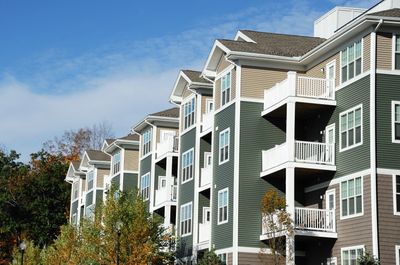How Depreciation Works in Multifamily Real Estate Investing
Depreciation is one of the most powerful tax advantages available to real estate investors, particularly those investing in multifamily properties. By leveraging depreciation, investors can significantly reduce their taxable income while enjoying the benefits of cash flow and long-term appreciation. At Blue Line Capital, we specialize in helping passive investors maximize the benefits of depreciation through carefully selected multifamily syndications.
Let's break down how depreciation works, why it’s so valuable, and how multifamily investors can use it to their advantage.
What Is Depreciation?
Depreciation is an accounting method that allows property owners to deduct the cost of a tangible asset over its useful life. For multifamily real estate, the IRS recognizes that properties experience wear and tear over time and provides a schedule for deducting the associated costs from taxable income.
While depreciation is designed to account for the property’s physical decline, the unique aspect of real estate is that properties often appreciate in value, creating a powerful tax-saving opportunity for investors.
How Depreciation Works for Multifamily Properties
The IRS allows depreciation for residential rental properties, including multifamily assets, over a period of 27.5 years. This means the property’s value (excluding the land) is divided by 27.5 to determine the annual depreciation deduction.
Example:
- Purchase Price: $10 million
- Land Value: $2 million (non-depreciable)
- Building Value: $8 million (depreciable)
Annual Depreciation Deduction = $8 million / 27.5 = $290,909
This $290,909 deduction can be used to offset taxable income generated by the property, reducing the investor’s overall tax liability.
The Role of Land in Depreciation
It’s important to note that land itself is not depreciable because it does not wear out or become obsolete. When calculating depreciation, the value of the land must be subtracted from the total purchase price to determine the depreciable basis.
The allocation of land versus building value is typically outlined in a property’s appraisal report. If the allocation is not specified, a cost segregation study can be used to accurately determine these values.
Cost Segregation: Accelerating Depreciation
Cost segregation is a tax strategy that breaks down a property into its individual components, allowing certain items to be depreciated over shorter time frames (e.g., 5, 7, or 15 years). These components might include fixtures, appliances, landscaping, and other non-structural elements.
By accelerating depreciation through a cost segregation study, investors can front-load their deductions and reduce taxable income significantly in the early years of ownership.
Example:
- A cost segregation study might identify that 20% of a property’s value consists of assets that can be depreciated over 5 years.
- This creates larger upfront deductions, boosting cash flow for investors.
Bonus Depreciation: Amplifying Tax Savings
Bonus depreciation, introduced under the Tax Cuts and Jobs Act of 2017, allows investors to deduct a significant portion of qualifying property costs in the first year of ownership. While the percentage of bonus depreciation is being phased down (from 100% in 2022 to lower levels in subsequent years), it remains a valuable tool for multifamily investors.
Key Points:
- Bonus depreciation applies to assets with a useful life of 20 years or less.
- It can be combined with cost segregation to amplify upfront tax savings.
By leveraging bonus depreciation, multifamily investors can create significant tax deductions in the first year, reducing their out-of-pocket tax expenses.
Passive Losses and Their Impact
Depreciation often creates “paper losses” on a property’s financial statements, meaning the deductions exceed the property’s net income. These losses are considered passive losses and can be used to offset other passive income, such as rental income from other properties.
Example:
- A multifamily property generates $100,000 in rental income.
- Depreciation and other expenses total $150,000.
- The $50,000 loss can offset income from other investments, reducing overall taxable income.
For passive investors in syndications, these losses are distributed proportionally, allowing you to benefit from the same tax savings as the sponsor.
Real Estate Professional Status (REPS)
For those who qualify as real estate professionals, depreciation can be even more powerful. Real estate professionals can use passive losses to offset active income, such as wages or business income.
To qualify as a real estate professional:
- You must spend at least 750 hours annually in real estate activities.
- More than half of your total working hours must be dedicated to real estate.
While this status isn’t applicable to most passive investors, it’s an important consideration for those heavily involved in real estate.
The Tax Benefits of Depreciation in Syndications
Multifamily syndications are structured to pass through depreciation benefits to passive investors. As an investor, you receive a share of the property’s depreciation deductions proportional to your ownership stake.
For example:
- If you invest $100,000 in a syndication that purchases a $10 million property, you might receive $10,000 in depreciation deductions annually.
- These deductions can offset your share of the rental income, reducing or even eliminating your tax liability on distributions.
Depreciation Recapture: What to Know
While depreciation provides substantial tax benefits, it’s important to understand depreciation recapture. When a property is sold, the IRS requires that you “recapture” the depreciation deductions you claimed.
Strategies to Mitigate Recapture:
- 1031 Exchange: Reinvest the proceeds into another property to defer taxes.
- Hold Period: Extend the hold period to continue benefiting from tax-deferred cash flow.
By planning ahead, investors can minimize the impact of depreciation recapture and preserve more of their gains.
Depreciation’s Role in Wealth Building
Depreciation is more than just a tax deduction—it’s a critical tool for building wealth. By reducing taxable income, depreciation enhances cash flow, allowing investors to reinvest in additional properties and grow their portfolios. Combined with appreciation and leverage, depreciation creates a trifecta of wealth-building potential that few other investments can match.

This website uses cookies.
We use cookies to analyze website traffic and optimize your website experience. By accepting our use of cookies, your data will be aggregated with all other user data.